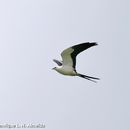en
names in breadcrumbs


The American swallow-tailed kite, Elanoides forficatus, is one of about 10 species of small hovering kites (subfamily Elaninae).This bird of prey can be found in the southeastern United States and south to northern Argentina, east of the Andes Mountain range.Experts estimate about 10 percent of the global population inhabits the United States, most of them in southern tip of Florida, although the population extends from South Carolina through Texas. In the winter the North American and Central American populations migrate to South America. Before migrating, North American birds congregate in very large numbers about three pre-migratory staging areas in Florida.They return to the US to nest in mid-February.
The swallow-tailed kite was named for its deeply forked, swallow-like black tail. Adults have long, thin wings that span 1.1-1.3 meters (3.7-4.2 feet) from tip to tip.This wingspan is several times the length of their body. Their long wings allow them to fly at high speeds, and their tail adds maneuverability making them graceful and adept flyers. American swallow-tailed kites have white heads, necks and bellies; their backs are iridescent black, with streaks of green, purple, and bronze.Juveniles are duller in color, with streaking on their heads and belly.They also have shorter tails, with white tips, but otherwise are similar in appearance to adults.Females are slightly larger than males but the sexes are difficult to distinguish.
Swallow-tailed kites occupy a variety of forested, open and wetland habitats including cypress and mangrove swamps, lakeshores and riparian forests, savanna and prairie, and freshwater and brackish marshes. South American and overwintering northern populations seek out tropical humid forests and cloud forests.They live at altitudes from sea level up to 1800 meters (6000 feet), but can wander up to altitudes of 3000 meters (10,000 feet). Swallow-tailed kites nest near sources of water in especially tall trees, anywhere from 18 to 40 meters above the ground. For nesting, they favor pine and cypress trees trees.
Swallow-tailed kites forage on the wing, in groups.Sometimes foraging groups include more than 100 individuals. Insects, which they catch and eat in mid-air, make up most of the adult diet.Adult birds also eat a small amount of vertebrate prey, such as amphibians, reptiles, eggs and hatchling birds, and occasional bats and fish. Fledglings, on the other hand, are fed a diet made up mostly of vertebrates (especially frogs). In the tropics, swallow-tailed kites also eat fruit.To drink, they scoop water in their beak as they fly.
Swallow-tailed kites roost in groups of up to 30 individuals. Though mostly silent, they can communicate with short, weak, high-pitched whistles and twitters, especially during the annual breeding season.Courtship starts in February. Swallow-tailed kites carry out courtship posturing, aero-acrobatic displays and males perform courtship feedings.Adults form monogomous pair bonds, meaning that they pair with just one mate for the whole breeding season, although they do not necessarily form the same pairs in subsequent seasons. They breed communally, in small colonies of 2-5 nests. Both parents build the nest, a platform of sticks and twigs lined with moss or lichens and concealed in foliage.Nests are reused and remodeled year after year, but it has not yet been determined whether the same adults return to the previous year’s nest. Females lay 2-4 eggs, and the parents share the job of incubating the eggs for about a month.Both parents protect and feed the young in the nest until they fledge and become independent, about eight weeks after hatching.
Before 1880, American swallow-tailed kites ranged to the northern Midwest.Habitat destruction and hunting has since reduced the North American population to the southern U.S. They are protected by the U.S. Migratory Bird Act, listed as endangered in South Carolina, threatened in Texas, and "rare" in Georgia, but are not federally classified as a threatened species.Some estimate that populations in the US are increasing but it is unclear whether this is due to migration pattern changes or increases in absolute population numbers.
(BirdLife International 2012; Bouglougan 2016; Kilham 1980; Maganit 2007; Meyer et al. 2004; NatureServe 2015; Wikipedia 2016)